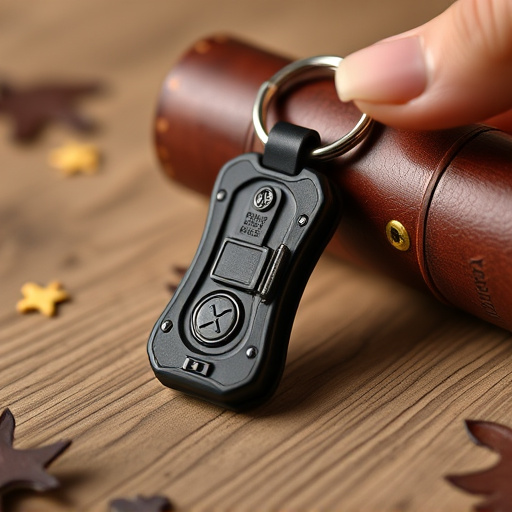Designing a legal self-defense keychain requires adhering to Legal Self Defense Keychain Regulations in your region, focusing on material safety, grip effectiveness, and compliance with local laws. Use durable materials like stainless steel or aluminum for a secure, comfortable grip while maintaining smooth edges and avoiding sharp blades prohibited by many jurisdictions. Prioritize ergonomic design, secure locking mechanisms, and a compact form factor to enhance usability and prevent accidental drops. Rigorous inspections ensure tensile strength, impact resistance, and control over sharp edges, making the keychain legally compliant, reliable, and safe for emergency protection.
In today’s world, self-defense is a serious consideration. Among popular choices, metal defense keychains offer a compact, always-ready solution. However, navigating legal self-defense keychain regulations and ensuring effective design are crucial steps before carrying one. This article provides comprehensive insights into understanding legal restrictions, choosing robust materials, considering grip and comfort design, and adhering to safety standards for creating a reliable metal defense keychain.
- Understanding Legal Self-Defense Keychain Regulations
- Choosing the Right Material for Your Keychain Grip
- Design Considerations for Effective Grip and Comfort
- Testing and Safety Standards for Metal Defense Keychains
Understanding Legal Self-Defense Keychain Regulations
When designing a metal defense keychain, it’s crucial to understand and adhere to the legal self-defense keychain regulations in your region. These rules govern what types of keychains are considered acceptable for personal protection and can vary significantly from one jurisdiction to another. In many places, laws specifically prohibit certain features commonly found in self-defense tools, such as sharp blades or strong springs that could cause serious injury.
Compliance with legal self-defense keychain regulations not only ensures your product’s legality but also enhances its safety. Always research and stay updated on local legislation to design keychains that meet these standards, providing users with a legitimate self-defense option without compromising public safety.
Choosing the Right Material for Your Keychain Grip
When designing a legal self-defense keychain grip, selecting the appropriate material is paramount. The key chain’s primary function is to provide a secure and comfortable grip for easy access during emergencies, so durability and texture are key considerations. Opt for high-quality metal alloys like stainless steel or aluminum, known for their strength and resistance to wear and tear. These materials offer excellent grip when combined with textured surfaces or patterns, enhancing your control and maneuverability.
Keep in mind the legal self-defense keychain regulations in your region regarding the type of weapons and accessories permitted. Some areas have restrictions on the weight, size, and overall design of self-defense tools. Choosing the right material ensures not only effectiveness but also compliance with these regulations, making it a practical and safe choice for personal protection.
Design Considerations for Effective Grip and Comfort
When designing a metal defense keychain for legal self-defense purposes, grip is paramount. Consider the user’s hand size and shape to ensure a comfortable fit. Ergonomic designs that contour to the palm and fingers enhance control, allowing for swift and precise deployment in stressful situations. Textured surfaces or grooves can significantly improve grip, preventing accidental drops when every second counts.
Legal Self Defense Keychain Regulations vary across regions, so it’s crucial to design with these in mind. Features like a secure locking mechanism and a streamlined, compact form factor are essential for compliance while maximizing utility. Smooth edges and durable materials not only ensure the keychain is safe to carry but also prevent it from becoming a hazard itself, adhering to best practices for responsible self-defense tool ownership.
Testing and Safety Standards for Metal Defense Keychains
When designing and manufacturing metal defense keychains, adhering to safety standards is paramount. These regulations, often governed by legal self-defense keychain restrictions, ensure that such tools do not cause unnecessary harm but remain effective for their intended purpose. Key factors include material quality, edge sharpness, and overall construction integrity. Manufacturers must conduct thorough testing to guarantee the product’s performance meets industry benchmarks without compromising user safety.
Compliance with legal self-defense keychain regulations involves rigorous inspections and certifications. This process encompasses various tests, such as tensile strength assessments, impact resistance evaluations, and sharp edge control checks. By meeting these standards, designers ensure that their creations are not only legally compliant but also reliable and safe for those who rely on them for protection in emergency situations.
When designing a metal defense keychain, adhering to legal self-defense keychain regulations is paramount. By selecting robust materials, incorporating ergonomic designs for comfort and grip, and ensuring comprehensive safety testing, you can create an effective personal defense tool. Remember, the right keychain grip can mean the difference between a secure, life-saving device and an awkward, ineffective one.
